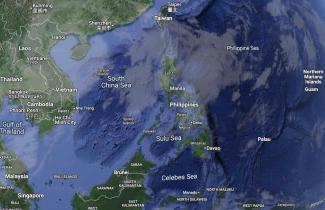East Sea warms up as US inches closer to India
The 'POTUS' – The President of the United States left India after witnessing a colourful 66th Republic Day celebration on January 26 as the chief guest. Despite a brief spoiled sport played by nature on the Day, the shortened three-day visit (Jan 25-27) of the US President to New Delhi has created an uneasy ripple in Beijing. It is not only the reiteration of faith in freedom of navigation in and around the East Sea (South China Sea) alone but also breaking the logjam on civil nuclear cooperation, backing for a permanent seat in the reformed UN Security Council and assurance in supporting India's full membership of the four international export control regimes, including Nuclear Supplier Groups (NSG), that have sent several aftershocks to Beijing.
While China has been closely watching this newfound camaraderie between the leaders of the oldest and largest democracies, several layers of its power structure have reacted cautiously. China seemed to be sulking privately, but it was not surprised by a mutual understanding between the US and India regarding the East Sea. Both countries agreed on a Joint Strategic Vision for the Asia-Pacific and Indian Ocean Region on 25 January.
Joint Strategic Vision for East Sea
The US’s 'Asia pivot' or 'rebalancing' primarily focusing on Asia-Pacific has reached its logical conclusion through this Strategic Vision. The Vision emphasises and reaffirms the 'importance of safeguarding maritime security and ensuring freedom of navigation and overflight throughout the region, especially in the South China Sea'. Despite China’s massive overseas investments in Asia-Africa for infrastructure-led development, far greater than the combined contribution of both the US and India, the partnership between the two countries, as the Statement says, is 'indispensable to promoting peace, prosperity and stability in the Asia Pacific and Indian Oceans.’
Both India and the US reiterated that the East Asia dispute must be resolved peacefully according to universally recognized principles of international law, including the United Nations Convention on the Law of the Sea (UNCLOS). The threat of force to resolve territorial and maritime disputes is unacceptable to both countries. However, the Chinese Foreign Ministry Spokeswoman commented (on January 26 and 27) that disputes in the East Sea (South China Sea) should be resolved through dialogue and consultation between countries directly concerned, not outsiders. The Foreign Ministry suggests that countries out of the region (referring to the US and India) should respect regional efforts and maintain the serenity of the South China Sea!
India and the US are set to develop a roadmap for securing the Asia-Pacific and the Indian Ocean. As 21st-century world politics shift gear unexpectedly with geopolitics' overtones, the Joint Vision intends to strike a deterrence on China’s growth in Asia and Africa. One such strategy is reinvigorating the East Asia Summit, which recently concluded its 9th Summit in Myanmar (Burma). The next Summit, comprising all ASEAN countries -- Australia, India, South Korea, Japan, New Zealand, the US, the Russian Federation and China -- intends to discuss regional political and security issues, according to the Vision Statement, which aims at East Sea. The Joint Vision also promotes robust trilateral consultations with third countries in the region. If the US and India chose Viet Nam in coming years for such a trilateral consultation, wouldn’t the East Sea be warmer?
Nuclear Supplier Group
China also expressed concerns about President Obama’s offer to support India’s membership in the 48-nation Nuclear Suppliers Group (NSG), an organization devised to ensure that civilian nuclear trade is not diverted for military uses. NSG controls almost all international nuclear trade, and its membership enables countries to freely use technology and nuclear material from other nations.
As for India's accession to the NSG, China maintains that only careful consideration by all member countries through consensus would make that expansion. The Chinese Foreign Ministry put a red flag by advising the Indian government to take measures to meet relevant requirements - most notably, India's signing of the NPT (Nuclear Non-proliferation Treaty). China is emerging as a major exporter of nuclear technology. By pointing to a decision based on consensus for the inclusion of new members, China has sent a message that any moves by the US to include India would be vetoed in NSG. Similarly, China will block India's long-standing demand for a permanent seat in the UN Security Council.
It is interesting to note that as India and the US dismantle their distances, China and Russia's proximity to Pakistan is increasing. Even if we like it, the Cold War mentality has not withered away completely. If a Cold War 2.0 had started at the frontiers of Russia and the West upon Ukraine, its splintered takeaway effect would have been seen elsewhere. After forming a new government in Sri Lanka early this month, the so-called Chinese 'String of Pearls' strategy in the Indian Ocean seems to be falling apart. While Obama was in Delhi, a visiting Pakistan Army received assurance from China that Pakistan is its 'irreplaceable' all-weather friend. Reciprocating with the same vibes during a Seminar, the National Security Advisor to the Prime Minister of Pakistan echoed that 'the new leadership in China has set out a vision of deeper engagement with South Asia, raising the prospects of advancing shared goals of peace, security and prosperity'.
Meanwhile, India's External Affairs Minister is scheduled to visit China at the end of this week (1-3 February). The Foreign Minister level meeting will discuss both sides' bilateral, regional, and global issues of concern. It will be interesting to note whether the Chinese would query about the Strategic Vision. Although India would like to forge a delicate balance between US and China as the road map of the Joint Strategic Vision will be laid down sooner, India's stance on the East Sea will remain not only firm but more proactive.
